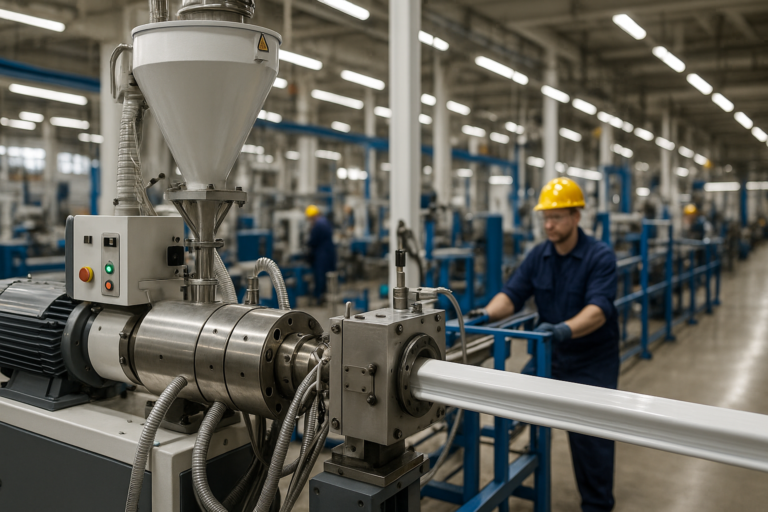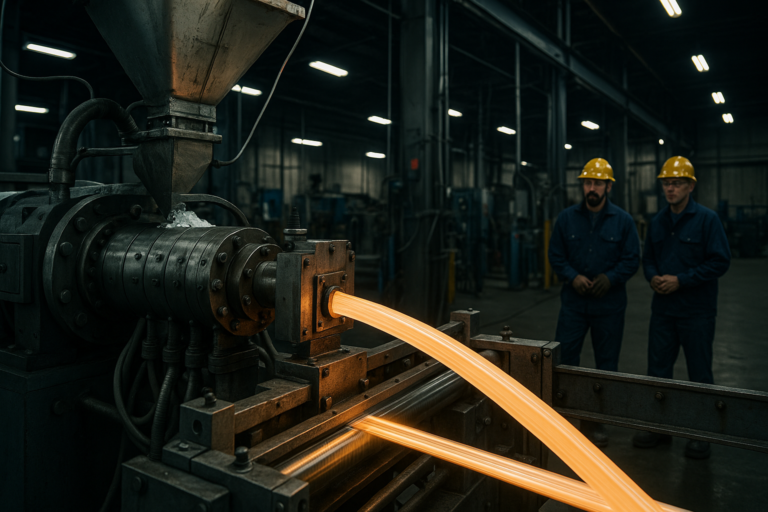Make some changes to the world environment
-
Building 3, Wanyang Innovation City, Langxia Street, Yuyao City, Zhejiang Province
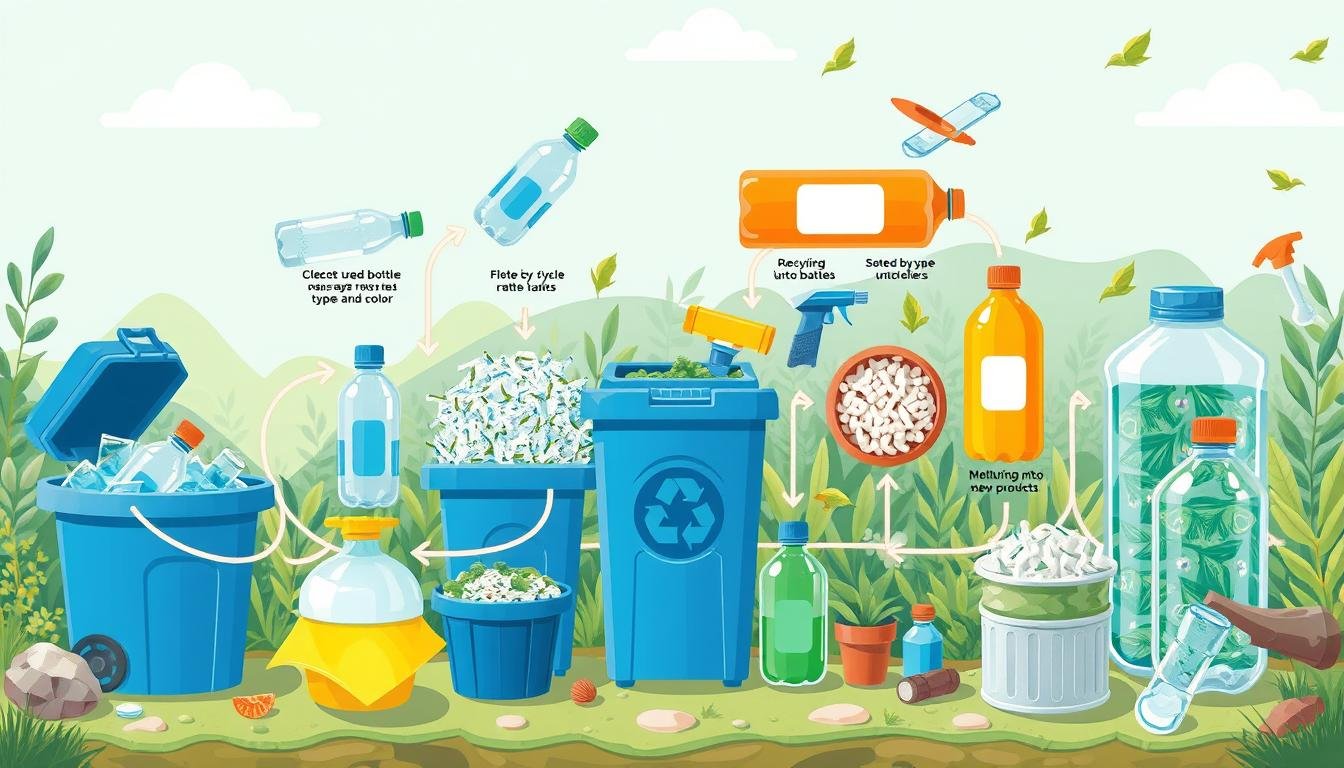
Recycling of Plastic Bottles: A Complete Guide
Did you know that Americans use 2.5 million plastic bottles every hour, with most ending up as single-use products? How many of these bottles return to the recycling loop, and what can we achieve by ensuring they do? Our plastic bottle recycling guide aims to answer these pressing questions and empower you to make a real difference.
Recycling plastic bottles is more than just an environmental responsibility; it is a pivotal action that can drastically reduce landfill waste and conserve energy. Recycling one ton of plastic bottles saves 1.5 tons of carbon emissions and conserves 66% more energy compared to using new, virgin materials1. With over 13 billion plastic bags produced annually, equating to about 300 bags per person, the need for efficient recycling methods is clearer than ever2.
In this comprehensive guide, we will delve into the types of plastics and their recyclability, the critical reasons to recycle, proper preparation techniques, the recycling process, and the various innovative uses for recycled plastics. We’ll also highlight how you can participate in local recycling programs effectively. Together, let’s discover the significant benefits of recycling plastic and learn how to recycle plastic bottles properly to foster a greener future.
Key Takeaways
- Understanding the high utility and recyclability of PET (#1) and HDPE (#2) plastics1.
- Recognizing the substantial energy savings from recycling plastic bottles1.
- Appreciating the economic and environmental benefits of community recycling programs3.
- Learning the preparatory steps for effective plastic bottle recycling3.
- Exploring innovative products crafted from recycled plastic bottles2.
Understanding Plastic Types and Their Recyclability
Understanding the different types of plastic is crucial for effective recycling. The most commonly recycled plastics include #1 PET (Polyethylene Terephthalate) and #2 HDPE (High-Density Polyethylene). #1 PET is predominantly used in beverage bottles and has a recycling rate of about 20%4. Despite this, countries like India, Europe, and South Korea have managed to achieve PET recycling rates higher than 50%5.
On the other hand, #2 HDPE is used in products such as milk jugs and detergent bottles. HDPE can be recycled multiple times, with the U.S. achieving a recycling rate of around 30%5. The benefits of recycling HDPE are significant as it can be transformed back into HDPE bottles or into composite plastic lumber6.
The recyclability of other plastics, labeled #3 to #7, presents more challenges. For instance, #3 PVC is not recyclable due to its toxicity, and #6 polystyrene is difficult to recycle, often classified as one of the worst plastics for environmental conservation4. Furthermore, sorting facilities generally cannot effectively sort #5 PP plastic, contributing to its meager recycling rate of 1-3% in the U.S5. and the lengthy decomposition time of 20-30 years5.
An interesting example is #4 LDPE plastic. While bottle and tub shapes of LDPE are not recyclable, film plastics such as grocery bags are commonly accepted for recycling at grocery stores4. These films are often recycled into composite plastic lumber6.
Statistics indicate that 91% of all plastic produced has never been recycled4, reflecting the critical need for better recycling infrastructure and practices. Single-use packaging comprises 40% of the plastic produced each year6, emphasizing the importance of adopting sustainable and effective recycling habits.
Although recycling efforts for plastics #3, #6, and #7 remain limited, the ongoing innovations and advancements in recycling technologies provide hope for a more sustainable future, particularly for highly recyclable plastics like #1 PET and #2 HDPE.
Why We Should Recycle Plastic Bottles
Recycling plastic bottles is essential due to its substantial environmental impact. A staggering 80% of all marine pollution is represented by plastic waste, endangering marine life and ecosystems7. In fact, approximately 100,000 marine mammals and 1 million seabirds die each year from plastic ingestion or entanglement7. This highlights the critical need for effective recycling measures to protect our oceans and wildlife.

Beyond the immediate danger to marine life, the environmental benefits of recycling plastic bottles are significant. The process of recycling and remanufacturing plastic waste can result in 30% to 80% less carbon emissions compared to producing new materials from scratch7. These energy savings are vital in combating climate change, as plastic production and incineration accounted for approximately 850 million tons of CO2 emissions in 2019 alone7.
Addressing the environmental impact of plastic waste also extends beyond energy conservation. Recycling efforts help mitigate the loss of valuable materials. Currently, only 9% of the world’s plastic is recycled, leading to an enormous economic loss, with 95% of the value of plastic packaging material being lost in the economy, equivalent to USD 80-120 billion annually7.
Moreover, recycling one ton of plastic can save 7.4 cubic yards of landfill space, preserving natural habitats and reducing the pressure on landfill sites8. Given that plastics accounted for more than 12% of the nation’s municipal solid waste in 2018, compared to less than 1% in 1960, the need for robust recycling initiatives is more pressing than ever8.
In summary, the act of recycling plastic bottles offers overwhelming benefits, from safeguarding marine life to conserving energy and reducing the environmental footprint. Our collective responsibility in recycling can lead to a healthier planet, where both ecosystems and economies thrive.
Proper Preparation for Plastic Bottle Recycling
To ensure efficient recycling of plastic bottles, proper preparation is crucial. This not only helps in conserving resources but also enhances the quality of the recycled material. Our first step should always involve *rinsing the bottles*. This practice removes contaminants that might otherwise hinder the recycling process.
Next, the debate over removing or keeping caps lingers. While some municipalities recommend leaving caps on for recycling, others advise removing them. Proper recycling of plastic bottles involves different protocols, so it’s best to check your local guidelines9. For most areas, tightly twisting caps on is acceptable9.
Label considerations also play a role in recycling preparation. While not all facilities require labels to be removed, doing so can optimize the recycling process. Following a thorough rinsing of the bottles, gently peel off any labels to make the recycling process smoother.
- Empty the bottle completely.
- Rinse the bottle to remove any remaining liquids or residues.
- Remove the label if required by your local recycling program.
- Screw the cap on tightly or follow local guidelines for cap removal.
By adhering to these steps, we can facilitate easier and more effective recycling processes. According to Earth Day, recycling even a single water bottle conserves enough energy to power a light bulb for three hours10. For more information on proper recycling practices, you can read about it on Scrap Management’s blog.
Finally, our collective effort in *rinsing the bottles* and following proper preparation guidelines can significantly contribute to reducing plastic waste and conserving resources. It’s a small step that leads to substantial environmental benefits.
The Process of Recycling Plastic Bottles
The recycling process for plastic bottles begins with the collection and sorting of plastics from curbside programs and designated recycling bins. This initial step is crucial for ensuring that only recyclable materials proceed through the recycling process. Once collected, the plastics are sorted both mechanically and manually to separate different types of polymers, such as PETE and HDPE11.
Following the sorting phase, the plastic bottles undergo a thorough washing process. This step is essential to remove any contaminants, labels, and residues that might hinder the efficiency of the subsequent recycling stages. The cleaned bottles are then shredded into small flakes, which makes handling and further processing more manageable.
“Around 8.3 billion metric tons of plastic have been produced in the last 70 years, with approximately 6.3 billion metric tons of that becoming waste, but only 9% of plastic waste has been recycled so far”11.
In the next phase, the cleaned and sorted plastic flakes are melted down to form a homogeneous mass. This melted plastic can then be molded into pellet form, which can be used in manufacturing new plastic products. Pelletizing is a critical step as it transforms raw recycled material into a versatile, reusable form.
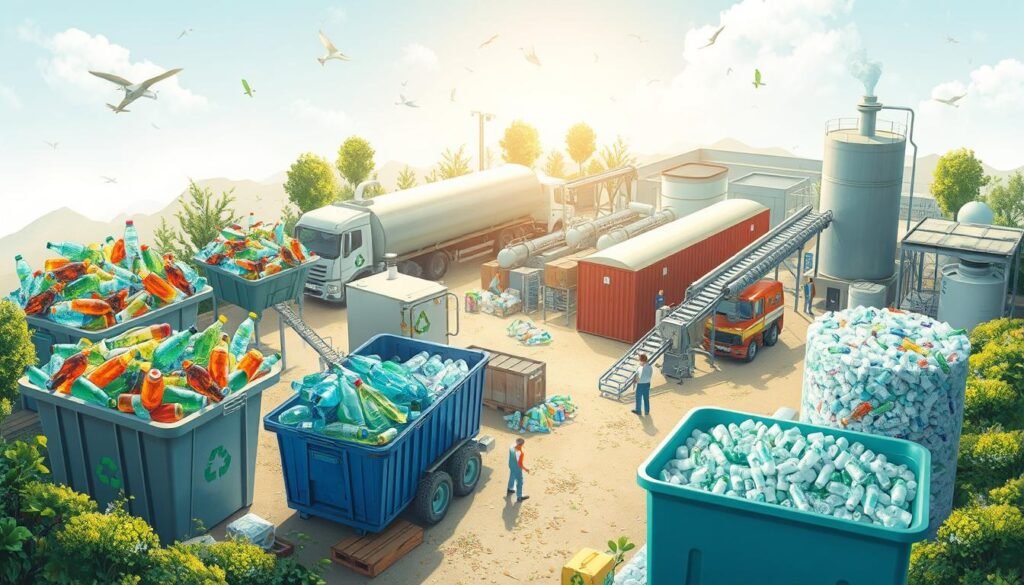
It’s worth noting that 29.1% of PET bottles manufactured in the US in 2018 were recycled, amounting to 910,000 tons12. This recycling effort significantly reduces energy consumption during the production of plastics, by as much as 75%12.
- Sorting of plastics involves both mechanical and manual separation techniques.
- Intensive cleaning turns plastic into clean flakes, removing contaminants and residues.
- The final step involves melting and pelletizing the plastic flakes into recycled pellets, ready for new product manufacturing.
The process of recycling plastic bottles is comprehensive and requires meticulous execution at each stage. From the initial collection and sorting, through washing and shredding, to the final melting and pelletizing, each step helps in contributing to a sustainable environment by reducing plastic waste. PET bottles alone take between 450-1000 years to decompose, making recycling efforts critical for reducing environmental impact12.
Recycling of Plastic Bottles and Local Programs
Local government and community-based programs play a significant role in facilitating the recycling of plastic bottles. Americans purchase billions of plastic beverage bottles annually, creating a substantial volume of recyclable material that needs to be managed and processed13. Efforts such as community recycling initiatives help address this need by providing accessible recycling points and information to residents.
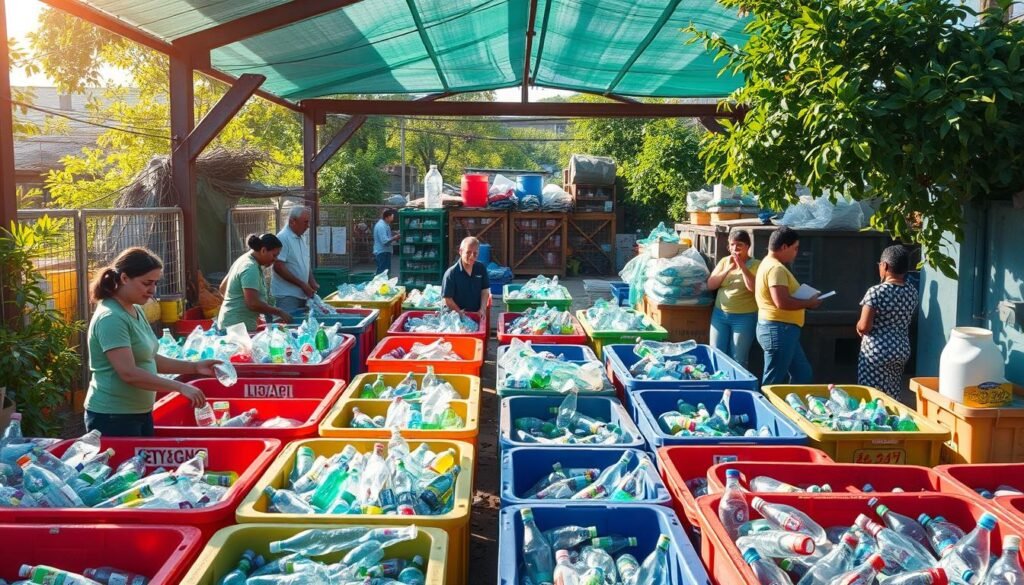
Plastic bottles and jugs, typically made from #1 plastic (PET) or #2 plastic (HDPE), are commonly accepted in most local recycling programs, yet these programs can vary greatly by region13. For example, in North Carolina, plastic bottles and aluminum cans are banned from all landfills, highlighting the state’s commitment to effective recycling14. Different materials, such as beverage bottles marked with a NY 5 cent deposit, are part of regional initiatives like New York’s Bottle Bill, designed to encourage recycling efforts13.
Community recycling initiatives are often supported by robust educational campaigns targeting different demographics. In North Carolina, programs such as RE3.org target young adults, Recycle Guys focus on children, and Recycle More NC caters to individuals aged 35 and older, ensuring comprehensive community engagement14. Effective education on what and how to recycle, using signage, posters, and stickers, helps to maintain community involvement and the success of local programs.
The methods of recycling also differ by community, with some adopting single-stream recycling and others opting for multi-stream methods. The success of these methods is often reflected in recycling rates; some communities with strong recycling programs boast a 90% clean rate for specific materials15. This high level of success is typically due to a combination of community engagement, consistent communication, and adequate local recycling infrastructure15.
Moreover, the recycling industry in the U.S. faced significant challenges in 2018 when China, previously the largest importer of recyclable materials, banned imported plastic waste. This led to decreased market demand for recyclables and forced local programs to adapt their recycling strategies15. Residents play a crucial role in these adaptations by ensuring that their recyclable items are sorted correctly and by reducing plastic waste at home.
Innovative Uses of Recycled Plastic Bottles
Recycled plastic bottles are revolutionizing the textile industry by being transformed into fibers that are utilized in creating eco-friendly materials. Adidas has been at the forefront, manufacturing shoes made from ocean plastic, a significant step towards reducing waste and promoting sustainability. Another innovative application is seen with The New Raw in Thessaloniki, who produce 3D-printed street furniture from Greek household plastic waste16. These examples illustrate how the recycling innovation of plastic bottles is pushing the boundaries of conventional recycling.
Our exploration into recycled plastic products wouldn’t be complete without noting the contributions to the construction materials industry. MacRebur, a pioneering company, incorporates single-use plastics into road construction, thus significantly lowering the carbon footprint16. Additionally, in South Africa, schools have been constructed using ecobricks, made from plastic bottles packed with single-use plastics16. Such practical and environmentally conscious innovations highlight the versatility and potential of recycled plastics in construction.
Recycling plastic bottles not only benefits specialized industries but also finds its way into everyday products. Household items like flower pots by Elho, which incorporate approximately 12 plastic detergent bottles per watering can, showcase everyday innovation16. We can observe how recycled plastic products are permeating our daily lives, offering sustainable alternatives to traditional materials.
The reuse of plastic bottles has yielded numerous creative applications, with over 60 different ways documented, including turning them into bird feeders, terrariums, and water filters17. This adaptability further underscores the significant reduction in plastic waste when these bottles are creatively repurposed. Notably, 100% of recycled plastic bottles can be upcycled without the need for comprehensive recycling processes, showcasing their efficiency and environmental benefits18.
Conclusion
Reflecting on the significant environmental and economic benefits of recycling plastic bottles, we reinforce how these actions align with sustainable practices and ensure our environmental responsibility. The journey of a plastic bottle from our homes to new products involves sorting, washing, shredding, and compounding, each stage crucial in mitigating environmental harm and promoting resourcefulness19. This process provides an opportunity to reduce pollution and conserve energy, underscoring the benefits of recycling.
Despite the potential advantages, only about 9% of all plastic waste ever produced has been recycled, as highlighted by National Geographic, revealing a significant gap in our recycling efforts20. More than one million plastic bottles are purchased globally every minute, with Americans alone contributing to approximately 50 billion water bottles annually20. This surge in plastic consumption necessitates increased awareness and participation in recycling programs.
Moreover, the United States Environmental Protection Agency promotes recycling to prevent plastics from polluting oceans and water sources, contributing to both environmental responsibility and economic growth through job creation and additional revenue19. As we look forward, our collective commitment to recycling and sustainable practices will be vital in preserving resources and protecting the environment for future generations. The benefits of recycling are clear, and it’s up to us to make them a reality by integrating these practices into our daily lives.


